
Figure 1 shows the geographical locations of the five test watersheds of SHE in Illinois. The size of these watersheds ranges between 100-3000 . The watershed boundary and stream network in these watersheds were delineated by the standard GIS hydrological application techniques using the USGS DEM data.
The simulations in this study include the major modules in SHE including channel flow, overland flow, unsaturated flow, groundwater flow, snow, evaporation, as well as the interactions (exchanges of water fluxes) between different modules. Table 1 summarizes the basic information of the application of SHE in five watersheds of Illinois. In this study, the simulation time step is 1-hour. SHE was driven with hourly time series of observed climatic forcing (precipitation and air temperature) and estimated potential evaporation. Precipitation was taken from the Earthinfo hourly precipitation dataset. In order not to distort the temporal structure of precipitation, only one precipitation station in each of these watersheds with the best data coverage was used to force SHE. Moreover, potential evaporation in those five watersheds was estimated from the multi-year off-line IBIS simulations by fixing the soil moisture at saturation and driving the IBIS with the observed atmospheric forcing in the specific watershed. Hourly temperature data, needed only for the snow module of SHE, was retrieved from the NCDC Surface Airway dataset. See Figure 2 for the geographical distributions of these climate stations in the Green Rive watershed and the Vermilion River watersheds. The precipitation data from Earthinfo stations #5751 and #2923, as well as the NCDC stations #14923 and #14842, were used as the forcing in the Green and Verimilion River watershed, respectively. Figure 3 shows the estimated potential evaporation from the off-line IBIS modeling.

Figure 1 The locations and the stream networks of the five watersheds in Illinois. From top to the bottom: Green river watershed, Vermilion river watershed, Hadley creek watershed, Horse river watershed, and Cache river watershed.
|
Watershed Name |
Area (sq. km) |
Simulation Period |
SHE Grid Resolution |
Total number of grids |
|
(1) Green River |
2059 |
1986-1994 (9 ys.) |
500m |
8236 |
|
(2) Vermilion River |
3203 |
1986-1994 (9 yrs) |
500m |
13278 |
|
(3) Cache River |
625 |
1986-1994 (9 yrs.) |
500m |
2806 |
|
(4) Hadley Creek |
188 |
1984-1986 (3 yrs.) |
83.3m |
29140 |
|
(5) Horse Creek |
249 |
1985-1987 (3 yrs.) |
83.3m |
37778 |
Table 1: The basic information of the SHE simulations in the five watersheds in Illinois. (The 83.3m grid resolution used in the two small watersheds is the resolution of the USGS DEM data used in this study. For the other three watersheds, the 83.3m DEM data were averaged to the 500m grid resolution)
In the Green river watershed (the same Earthinfo precipitation and NCDC temperature data as just summarized were also the forcing in the IBIS modeling). Both the magnitude and the annual and diurnal pattern of the estimated potential evaporation seem to be well-simulated. In addition, the USGS daily streamflow data at the watershed outlet were used for the calibration and validation of SHE simulations.

Figure 2 The geographical distribution of the climate stations (EarthInfo hourly precipitation and NCDC Surface Airway hourly dataset) in the Green and the Vermilion Watersheds

Figure 3 The potential evaporation estimated from the IBIS off-line modeling location in Green river watershed, Illinois.
Figure 4 plots the 1985-1994 monthly time series, the seasonal cycle, and the annual totals of the input and validation data in the Green River watershed: precipitation, potential evaporation, and streamflow.
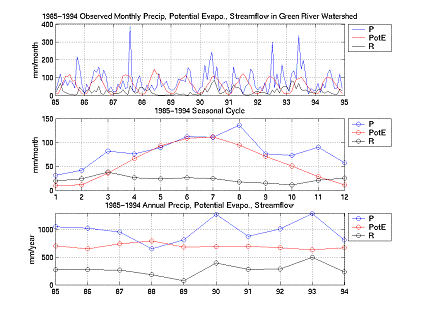
Figure 4 The monthly time series, the seasonal cycle, and the annual totals precipitation (P), potential evaporation (PotE), and streamflow (R) from 1985-1994 in the Green river watershed.
The soil type and land cover were specified as the silt loam and the cropland in all of five watersheds, which is the dominant types of soil and vegetation in Illinois. Since the major objective of this study is to investigate the surface water-groundwater-stream interaction by using the distributed hydrological system SHE rather than accurately predicting streamflow, the spatial variability of precipitation, soil type, and land cover are neglected for simplicity. The investigation of the impacts of the spatial variability in the climate forcing as well as the land surface properties is left as a future research topic.
The two most significant parameters in SHE controlling the quantity and timing of runoff generation, the horizontal hydraulic conductivity of the aquifer and the Manning coefficient of overland flow, were calibrated against the USGS observed daily streamflow. Figure 5 summarizes the daily streamflow simulation of SHE in comparison with the USGS daily streamflow records. Figure 6 shows the similar comparisons, but at the monthly and annual time scales. Moreover, two major streamflow components, groundwater runoff and surface runoff, are shown separately in Figure 7. Notice that in the SHE the surface runoff is composed of the infiltration-excess (Hortonian) runoff and the saturated-excess (Dunne) runoff, while groundwater runoff is the sum of spring discharge (i.e., groundwater intersects with topography before injecting into stream channels) and dry baseflow (i.e., groundwater discharges to stream without flowing onto the ground surface). It should be mentioned that the monthly spring discharge to streams was estimated from the summation of SHE’s daily "saturated flow from aquifers to ground surface" into the monthly timescale, which is actually the runoff generation rather than streamflow. Therefore, it should be only considered as a first-order approximation of the spring discharge to streams, although the bias might be negligible at the monthly timescale.
As can be seen in Figures 5-6, the simulated streamflow in the Green River watershed agrees with the corresponding observations surprisingly well at all daily, monthly, and annual time scale. Given that the spatial variability of precipitation, soil and land covers were not considered at all, the results suggest that SHE is a powerful tool for watershed modeling. From Figure 7, the groundwater runoff contributes slightly more than 30% of the total streamflow in this watershed. Moreover, Figure 8 plots the 1986-1994 SHE simulations of the watershed-mean water table depth and the areal fraction of the saturated area in the Green river watershed. Groundwater rating-curve (i.e., watershed-mean aquifer storage-discharge relation) in the Green river basin at the monthly timescale is plotted in Figure 9; also the baseflow component of groundwater flow was shown by the red dots in the figure.
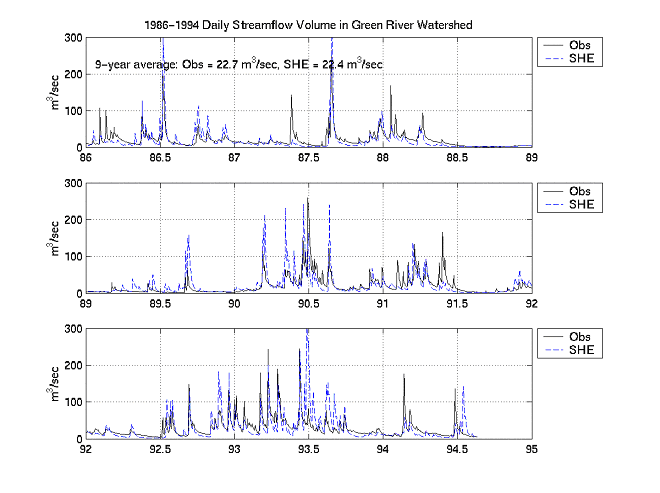
Figure 5 The 9-year (1986-1994) time series of the SHE-simulated daily streamflow in comparison with the observed USGS daily streamflow record in the Green river watershed.

Figure 6 The 9-year (1986-1994) monthly time series and the average seasonal cycle of the SHE-simulated streamflow in comparison with the observed USGS streamflow record in the Green river watershed.
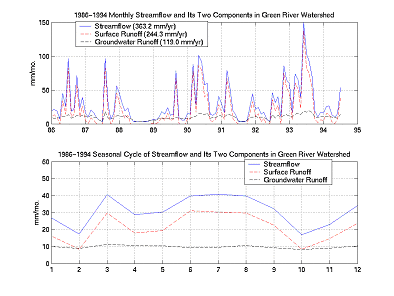
Figure 7 The 1986-1994 monthly time series and the average seasonal cycle of the SHE-simulated total streamflow and its two components, surface runoff and groundwater runoff in the Green river watershed.

Figure 8 The 9-year (1986-1994) monthly time series of the SHE-simulated, watershed-mean water table depth (WTD) and the fraction of saturated area in the Green River watershed.
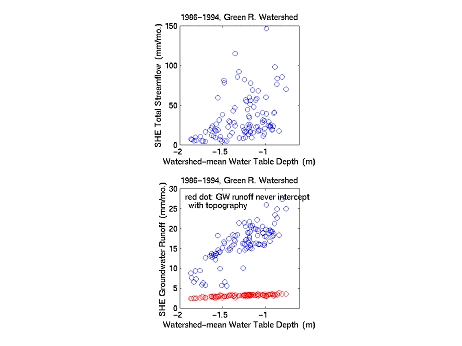
Figure 9 The scatter plots between the monthly (a) streamflow (b) groundwater runoff versus the watershed-mean water table depth (WTD) from 1986-94 in the Green river watershed. The red dots are the plot of the dry baseflow versus the WTD.
Figure 10 summarizes the daily streamflow simulation of SHE in comparison with the USGS daily streamflow records in the Vermilion River watershed. Figure 11 shows the same comparison, but at the monthly and annual time scales. The two major streamflow components, groundwater runoff and surface runoff, are also shown separately in Figure 12.
Moreover, Figure 13 plots the 1986-1995 SHE simulations of the watershed-mean water table depth and the areal fraction of the saturated area in the Vermilion river watershed. Groundwater rating-curve in the Vermilion river basin at the monthly timescale is plotted in Figure 14. The red dots in this figure show the relations between the dry baseflow and the wate table depth.

Figure 10 The 9-year (1986-1994) time series of the SHE simulated streamflow in comparison with the observed USGS daily streamflow record in the Vermilion river watershed.

Figure 11 The 1986-1994 monthly time series and the average seasonal cycle of the SHE-simulated streamflow in comparison with the observed USGS streamflow record in the Vermilion river watershed.
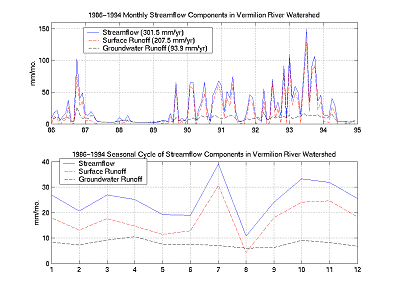
Figure 12 The 1986-1994 monthly time series and the average seasonal cycle of the SHE-simulated total streamflow and its two components, surface runoff and groundwater runoff in the Vermilion river watershed.

Figure 13 The monthly time series of the SHE simulated watershed-mean water table depth (WTD) and the fraction of saturated area from 1986-94 in the Vermilion river watershed.

Figure 14 The scatter plots between the monthly (a) streamflow (b) groundwater runoff versus the watershed-mean water table depth (WTD) from 1986-95 in the Vermilion river watershed. The red dots are the plot of the dry baseflow versus the WTD.
Figure 15 summarizes the daily streamflow simulation of SHE in comparison with the USGS daily streamflow records in the Cache River watershed. Figure 16 shows the same comparison, but at the monthly and annual time scales. The two major streamflow components, groundwater runoff and surface runoff, are also shown separately in Figure 17. Moreover, Figure 18 plots the 1986-1995 SHE simulations of the watershed-mean water table depth and the areal fraction of the saturated area in the Cache river watershed. Groundwater rating-curve in the Cache river basin at the monthly timescale is plotted in Figure 19.
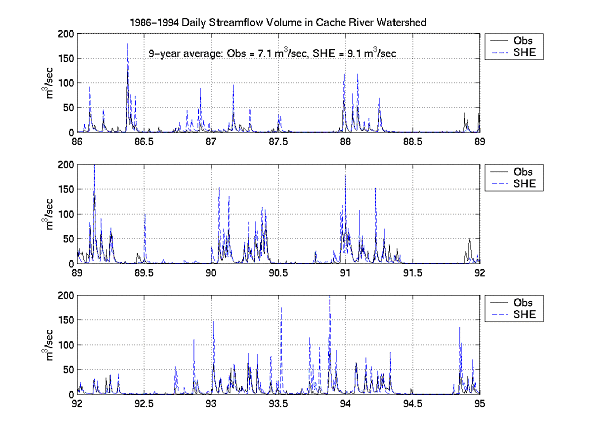
Figure 15 The 9-year (1986-1995) time series of the SHE simulated streamflow in comparison with the USGS observational daily streamflow record in the Cache river watershed

Figure 16 The monthly time series and the average seasonal cycle of the SHE simulated streamflow from 1986-1994 in comparison with the observed USGS streamflow record in the Cache river watershed.

Figure 17 The 1986-1994 monthly time series and the average seasonal cycle of the SHE-simulated total streamflow and its two components, surface runoff and groundwater runoff from 1986-1994 in the Cache river watershed.

Figure 18 The monthly time series of the SHE simulated watershed-mean water table depth (WTD) and the fraction of saturated area from 1986-94 in the Cache river watershed.
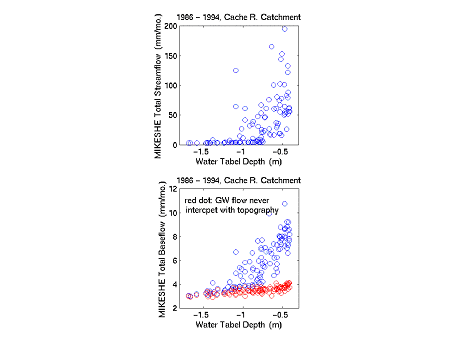
Figure 19 The scatter plots between the monthly (a) streamflow (b) groundwater runoff versus the watershed-mean water table depth (WTD) from 1986-95 in the Cache river watershed. The red dots are the plot of the dry baseflow versus the WTD.
Figure 20 summarizes the 3-year (1984-1986), SHE daily streamflow simulation in comparison with the USGS daily streamflow records in the Hadley creek watershed. Figure 21 shows the same comparison, but at the monthly and annual time scales.
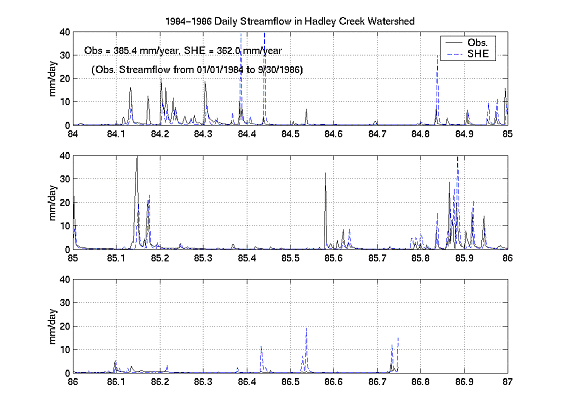
Figure 20 The 3-year (1984-86) time series of the SHE simulated streamflow in comparison with the USGS observed daily streamflow record in the Hadley creek watershed

Figure 21 The monthly time series and the average seasonal cycle of the SHE simulated streamflow from 1984-86 in comparison with the observed USGS streamflow records in the Hadley creek watershed.
Figure 22 summarizes the daily streamflow simulation of SHE in comparison with the USGS daily streamflow records in the Horse Creek watershed.

Figure 22 The 3-year (1985-87) time series of the SHE simulated streamflow in comparison with the USGS observed daily streamflow records in the Horse creek watershed.
We have summarized in this report the application of physical-based, distributed watershed modeling system SHE to the five watersheds in Illinois. Generally speaking, the simulated streamflow by SHE agrees with the observed streamflow rather well for the first three relatively large watersheds in Illinois (Green, Vermilion and Cache watersheds) even at the daily time scale. For the remaining two small watersheds both with ephemeral streams, Hadley creek and Horse creek watersheds, the simulation is of lesser accuracy due to the model deficiency in capturing the key processes for runoff generation in these two small watersheds. This is especially true for the fry regions - Horse creek watershed, where the streamflow is as low as only 131 mm per year.
Furthermore, it is interesting to notice that there exists a threshold water table depth beyond which the spring discharge begins to occur. For the Green River watershed, this depth is larger than 2m deep (see Figure 9); for the Vermilion River watershed, it is about 0.8m (see Figure 14); and for the Cache River watershed, it is about 1.2m (see Figure 19). This is consistent with the proposed non-linear (threshold-type) macro-scale groundwater model in the PhD thesis.
2003 Pat Yeh and Lincoln Fok